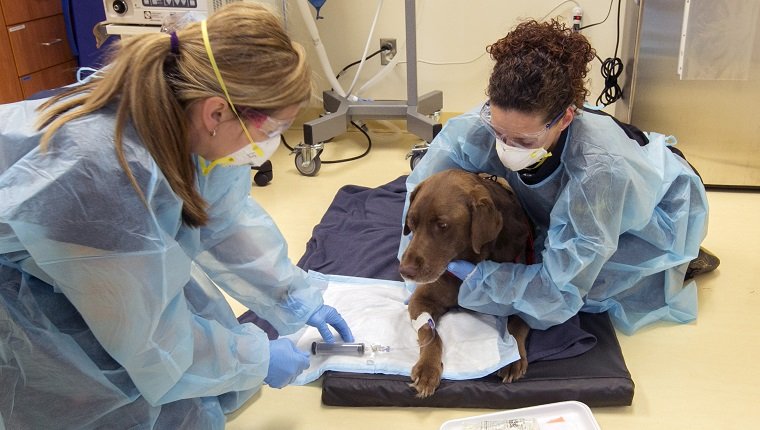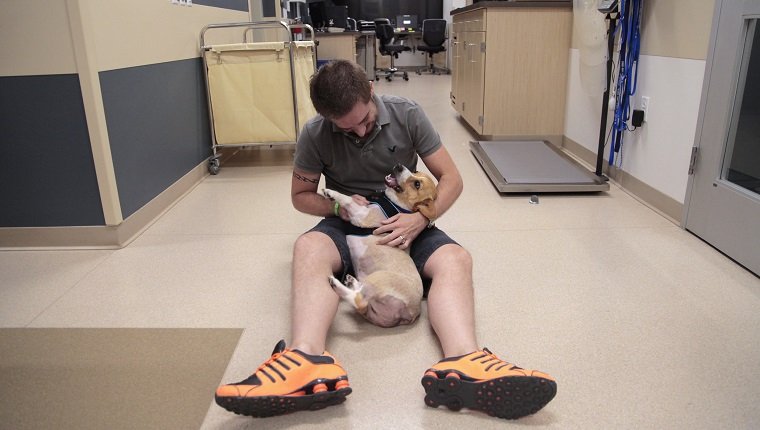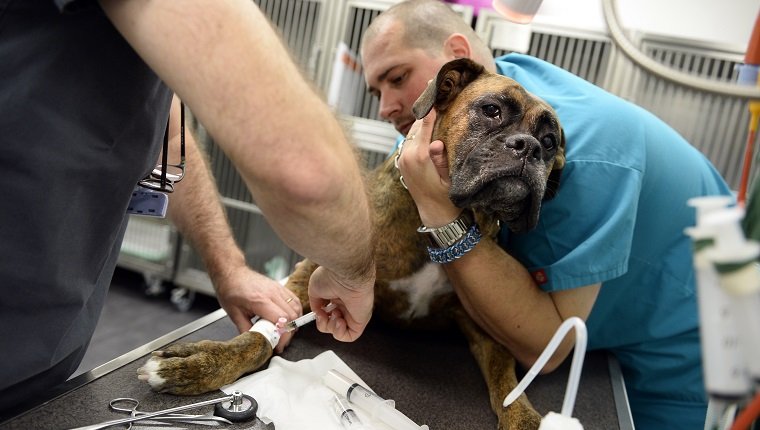Lymphoma is a form of cancer in dogs that affects the lymphocytes, which are white blood cells that are important for immune system function.
It’s one of the most common malignant tumors in canines. Mostly it’s found in the lymph nodes, the spleen, or the bone marrow, which is where lymphocytes are most concentrated. Although, it can appear in any organ of the body.
This cancer can be deadly for dogs if left untreated, so contact your vet if you suspect your dog needs treatment. Here’s what you should know about the types, causes, symptoms, and treatments for lymphoma.
Types Of Lymphoma In Dogs

“Lymphoma” is a term that covers more than 30 types of cancer in dogs that each differ in mortality rates, symptoms, and aggressiveness.
There are four types of lymphoma, however, that are most common:
- Multicentric lymphoma is the most common type and makes up 80 to 85 percent of cases in dogs. It mostly affects the lymph nodes, where you might expect to see swelling.
- Alimentary lymphoma is the second most common type. It affects the intestines, which is where you can expect to see the strongest symptoms.
- Mediastinal lymphoma is more rare and affects the thymus and the mediastinal lymph nodes, which are in the chest. You might see that area become enlarged.
- Extranodal lymphoma affects a specific organ. It can be the skin, kidneys, lungs, central nervous system, or other organs. Most often it affects the skin, which is called a cutaneous lymphoma.
The condition is also designated by stage based on how it metastasizes and how invasive it is.
The stages are as follows:
- Stage I happens when it only affects one lymph node.
- State II is regional lymphadenopathy, which means it only affects one side of the diaphragm.
- Stage III is generalized lymphadenopathy, which happens when the lymph nodes are enlarged.
- Stage IV is when you see enlarged liver or spleen.
- Stage V is when lymphoma affects bone marrow, the central nervous system, or other sites beyond the lymph nodes.
Causes Of Lymphoma In Dogs

The exact causes of lymphoma in dogs are unknown, but certain factors put dogs more at risk.
Dogs with compromised immune systems are more prone to the condition. Dogs exposed to herbicides and those who live in industrial areas are also at greater risk. Additionally, dogs who suffer exposure to toxic chemicals like paint and solvents show a greater predisposition.
Breed can also affect the likelihood of developing lymphoma. Airedale terriers, Basset Hounds, Boxers, Bulldogs, Golden Retrievers, Scottish terriers, and Saint Bernards are at increased risk.
Dog breeds at lower risk include Dachshunds and Pomeranians.
Symptoms Of Lymphoma In Dogs

Symptoms of lymphoma in dogs vary and mostly relate to where the tumor forms.
Tumors in the lymph nodes, for example, may appear as swelling with no other symptoms. Tumors in the gastrointestinal tract may cause symptoms like vomiting, diarrhea, weight loss, and lack of appetite.
Lymphoma in the chest may result in shortness of breath or weak heart beat. Forms that appear on the skin can result in bumps that may be itchy, red, or ulcerated.
Here are a few symptoms seen in the most common types of lymphoma:
- Multicentric usually appears as swollen lymph nodes. They can grow to three to ten times their normal size, though they aren’t painful. Lymph nodes will feel firm to the touch and move freely beneath the skin. The dog may also feel tired and weak, lose their appetite, and suffer dehydration or a fever.
- Alimentary may cause vomiting, abdominal pain, diarrhea, anorexia, and weight loss.
- Mediastinal results in difficulty breathing, changes in urination, increased thirst, and swelling in the face or front legs.
- Extranodal symptoms vary based on the affected organ. Cutaneous lymphoma that affects the skin results in raised nodules or lesions that can appear on the mouth, lips, and gums. When it appears in the lungs, it causes breathing issues. In the kidneys it causes renal failure, and in the eyes it causes blindness. In the central nervous system, it can cause seizures, and in the bones, it can lead to pain and fractures.
Treatments For Lymphoma In Dogs

The main treatment for lymphoma in dogs consists of chemotherapy. Veterinarians use a wide variety of drugs for this purpose and may give them to dogs orally or via injection.
Common drugs used in treatment are cyclophosphamide, vincristine, doxorubicin, and prednisone. Vets may also use radiotherapy for treatment. In some cases, vets may attempt bone marrow transplants or other surgery.
The life expectancy for a dog at Stages III through V is about four to six weeks, and drugs aren’t likely to prolong their lifespan. Dogs can, however, take medication to reduce swelling and improve quality of life at the end.
Chemo can typically extend dogs’ lives for about a year. Although, it’s important to note that there is no cure for the disease, and relapse is very likely.
The condition has a high mortality rate. Therefore, the goal of treatment is most often to improve quality of life.
Do you keep up with vet visits to check your dog for conditions like lymphoma? How do you keep your dog healthy? Let us know in the comments below!










